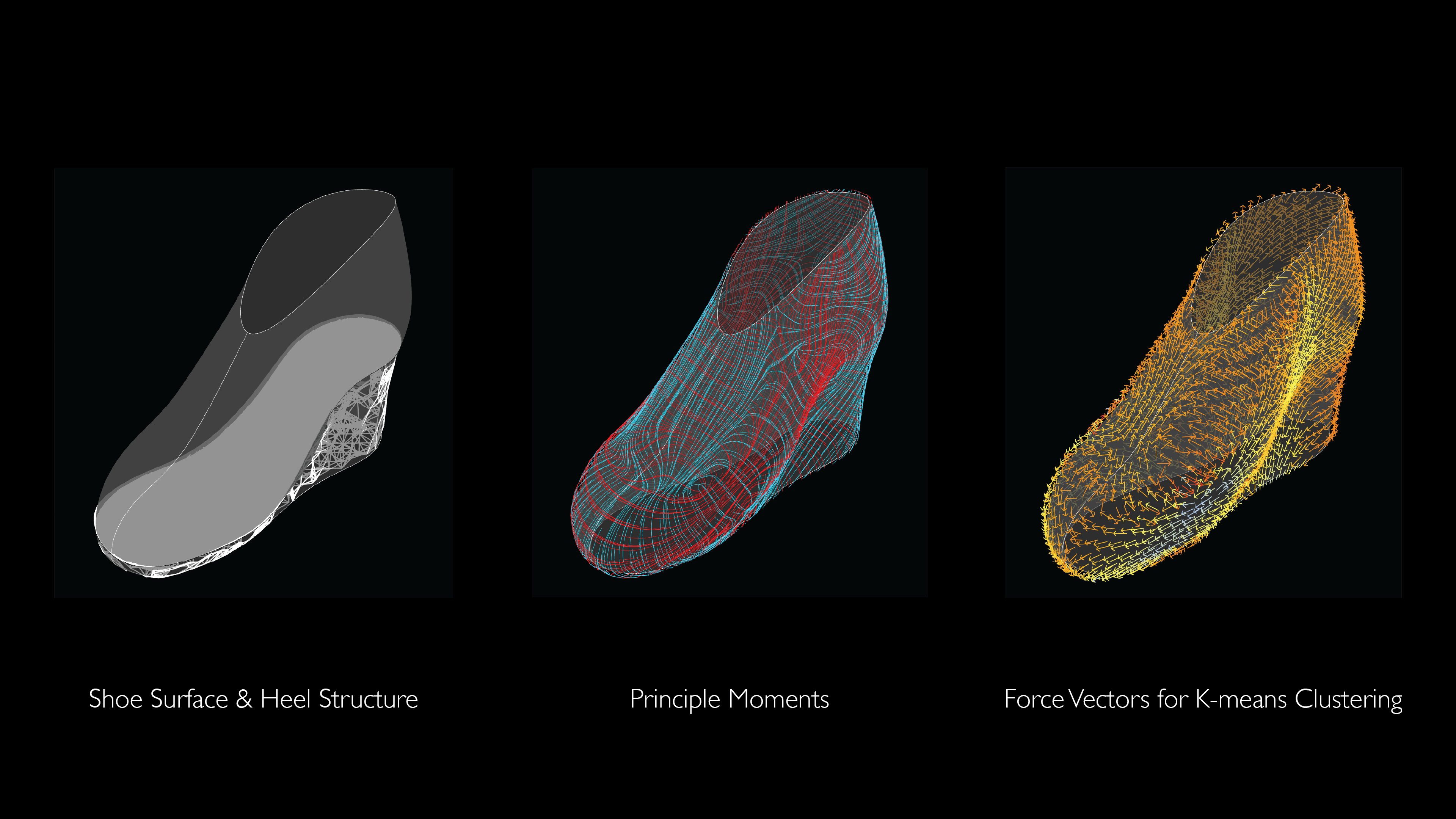Shoe in Motion
Design with Artificial Intelligence based Process 1
Die Angewandte
Design with Artificial Intelligence based Process 1
Die Angewandte
Students: Hao Wu, Patrik Drechsler
Supervisor: Zeynep Aksöz
Review Guests: Rem D. Koolhaas
![]()
Concept Statement
Our approach to high heel design is set within a contemporary socio-cultural context, using AI-based methods in order to translate movement, as an expression of stereotypical gender roles, into design.
We initiated our design by questioning the general relevance of the high heel in the 21st century. We believe that the high heel finds its specific cultural relevance within the expression of gender, emphasizing certain body movements which are based on stereotypical notions of “feminine” and “masculine”.
Therefore, we attempted to understand the roots defining the motion typologies as “feminine” or “masculine” within the popular culture. The result was based on two icons used as case studies; supermodel Naomi Campbell and Western star Clint Eastwood, both emphasizing two distinct high heel walks.
After the motion-typology identification process, the movements were translated into geometrical parameters forming an algorithm which applies motion trackers to the two differently rigged models, finally extrapolating force vectors for each movement phase. Furthermore, we analysed the relationship between the height and width of a heel, according to the desired walking style, narrowing our range of changing parameters to three main influences: vector forces, height and width of the heel.
However, while the height and width were seamlessly translated into the design, the motion vectors were applied on different occasions. Firstly we were provoking the desired form of movement by adapting the heel structure to its respective force vector using the Karamba plug-in for Grasshopper, automatically adjusting the ideal structure to the input vector. Secondly, the force vectors influencing the design of the main structure were also influencing the hull’s outer shell, reacting to the motion vector and emphasizing the desired movement. The influence on the hull is also visually translated by plastifying the acting forces into the vertical and horizontal tension lines. Finally, the extracted vortex lines, acting as a connection as well as bracings for the shell, are giving an additional unique style to the design according to its chosen motion.
So the range of stereotypical body movements is processed by the AI based algorithm in real time and directly applies to the functionality and expression of the high heel design.
The visual expression is therefore picking up on the socio-cultural relevance of gender fluidity, by channeling our personal interest in contemporary art forms which embrace it (such as hyperpop, where the materialistic expression of the music and artists is aesthetically idelized in shiny and brightly coloured materials, often related to plastic or bubbles). Therefore, the incorporation of idealized aesthetics within our shell would formally impose it to the rationalized inner grid structure, representative for the process of the AI-based algorithm.
Supervisor: Zeynep Aksöz
Review Guests: Rem D. Koolhaas

Concept Statement
Our approach to high heel design is set within a contemporary socio-cultural context, using AI-based methods in order to translate movement, as an expression of stereotypical gender roles, into design.
We initiated our design by questioning the general relevance of the high heel in the 21st century. We believe that the high heel finds its specific cultural relevance within the expression of gender, emphasizing certain body movements which are based on stereotypical notions of “feminine” and “masculine”.
Therefore, we attempted to understand the roots defining the motion typologies as “feminine” or “masculine” within the popular culture. The result was based on two icons used as case studies; supermodel Naomi Campbell and Western star Clint Eastwood, both emphasizing two distinct high heel walks.
After the motion-typology identification process, the movements were translated into geometrical parameters forming an algorithm which applies motion trackers to the two differently rigged models, finally extrapolating force vectors for each movement phase. Furthermore, we analysed the relationship between the height and width of a heel, according to the desired walking style, narrowing our range of changing parameters to three main influences: vector forces, height and width of the heel.
However, while the height and width were seamlessly translated into the design, the motion vectors were applied on different occasions. Firstly we were provoking the desired form of movement by adapting the heel structure to its respective force vector using the Karamba plug-in for Grasshopper, automatically adjusting the ideal structure to the input vector. Secondly, the force vectors influencing the design of the main structure were also influencing the hull’s outer shell, reacting to the motion vector and emphasizing the desired movement. The influence on the hull is also visually translated by plastifying the acting forces into the vertical and horizontal tension lines. Finally, the extracted vortex lines, acting as a connection as well as bracings for the shell, are giving an additional unique style to the design according to its chosen motion.
So the range of stereotypical body movements is processed by the AI based algorithm in real time and directly applies to the functionality and expression of the high heel design.
The visual expression is therefore picking up on the socio-cultural relevance of gender fluidity, by channeling our personal interest in contemporary art forms which embrace it (such as hyperpop, where the materialistic expression of the music and artists is aesthetically idelized in shiny and brightly coloured materials, often related to plastic or bubbles). Therefore, the incorporation of idealized aesthetics within our shell would formally impose it to the rationalized inner grid structure, representative for the process of the AI-based algorithm.
Final Animations
Final Renderings




Trace of Human Legs
Design Parameters

Comparing Male Walking Pattern and Female Walking Pattern

Extract Motion of Force Vector

General Structural Pattern by Motion of Force Vectors

K-Means Clustering to find Structures

Matrics of different Walking Patterns

Detail Force Flows

All right received